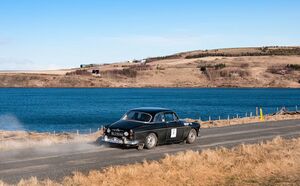Eilínótt
This article is incomplete because it is pending further input from participants, or it is a work-in-progress by one author. Please comment on this article's talk page to share your input, comments and questions. Note: To contribute to this article, you may need to seek help from the author(s) of this page. |
Kingdom of Eilínótt The Eternal Kingdom of Night Konungsríkið Eilínótt Eilíft Næturríki | |
|---|---|
| Anthem: The Still of the Night | |
| Capital and city | Sæeilítur |
| Official languages | Næturræða |
| Also spoken | Ostlander • Trinovantan |
| Ethnic groups | Næturfrændi |
| Demonym(s) | EilínóttI |
| Government | Hereditary monarchy |
• Konungur | Ásgeir Indriðison Freyr (Ásgeir III) |
• Regent | Baldur Leifurson Vídalín |
| Establishment | |
• Discovery by Trinovantan | 897 CE |
• Part of the Trinovantan Empire | 973 CE |
• Independence from Trinovantum | 1804 CE |
| Population | |
• 2020 census | 351,974 |
| GDP (nominal) | estimate |
• Total | 20.8 billion |
• Per capita | 59,095 |
| Currency | Dökkmynt (ᛟ) |
| Date format | mm/dd/yyyy |
| Driving side | right |
| Calling code | +999 |
Eilínótt, officially referred to as the Eternal Kingdom of Night (Næturræða: Eilíft Næturríki) is an island nation located in the northern Thetian Ocean. With a population of 351,974, it is one of the most sparsely populated nations of Annwynn. The capital and largest city, Sæeilítur, is located on the northwestern portion of the island, comprising one o the nations three administrative regions, known as svæðum. Sæeilítur was first settled in 897, and is believed to be the first settlement established upon the island. In addition, the majority of the population of the nation is concentrated in both the Höfuðborgarsvæði, or capital region, and the larger Vestursvæði (western region) encompassing it. There are, however, several populated settlements along the costal regions across the island, as well as some sparsely populated settlements in the island interior.
Following discovery by the Trinovantan Empire in 897, Trinovantan settlers established a presence on the island. In the following centuries, other Ordian peoples emigrated to Eilínótt, bringing with them trylle (i.e., slaves or serfs) of Aisling origin. In 973, the island was formally incorporated into the Empire and remained a part of it until it achieved independence in 1804. Despite its independence from the Empire, Eilínótt shares a strong cultural heritage with Trinovantum, as well as several other Ordian nations.
The economy of Eilínótt relies largely on subsistence fishing and minor agricultural efforts, though in modern times, the Eilínótti service and tourism industries have been expanded, and now consist of a significant portion of the nation's GDP. Industrialization of the fisheries and other concerns have also introduced further efficiency into the nations impressive fishing sector. In 1994, Eilínótt became a member of the Ordian Economic Initiative, further diversifying the nation's economy into sectors such as finance, biotechnology, and manufacturing. Eilínótt has a market economy with relatively low taxes, often seen as a tax haven by foreign corporations.
Etymology
History
Geography
Climate
Eilínótt is volcanically and geologically active. The interior consists of a plateau characterized by sand and lava fields, mountains, and glaciers, and many glacial rivers flow to the sea through the lowlands. Its high latitude and marine influence keep summers chilly, and most of its islands have a polar climate.
Government
Government Ministries
Political parties
Political divisions
Military
Law Enforcement
Economy
Energy
Eilínótt runs almost completely on renewable energy.
Infrastructure
Roadways
Route 1, or the Ringway, (Næturræða: Hringvegur), and originally called the Ringstraße, was completed in 1978 by the occupation government of Ostlichtor. The existing unpaved road system of Eilínótt proved inadequate for rapidly moving material and supplies around the island, and in 1974, shortly after taking possession of the island, the Ostlander government authorized the construction of a single highway that would circle the island connecting all inhabited costal locations. Some effort was made between 1979 and 1982 by the occupation government to pave roadways between the several small interior settlements of the island. These efforts ended in 1982 when control of the island was retuned to the Eilínótti people. Efforts to continue improving roadway infrastructure continued through the 1980s and 1990s, with the interior settlement of Schneeschuh being the last settlement to be linked to the rest of the nation by paved roads in 1995
Demographics
Largest cities and towns in Eilínótt
2020 National Census | |||||||||
|---|---|---|---|---|---|---|---|---|---|
| Rank | [[s of Eilínótt|]] | Pop. | |||||||
 Sæeilítur  Myrkurbær |
1 | Sæeilítur | Höfuðborgarsvæði | 233,034 |  Stórreykjabær  Fyrstaijós | ||||
| 2 | Myrkurbær | Vestursvæði | 35,966 | ||||||
| 3 | Stórreykjabær | Vestursvæði | 29,409 | ||||||
| 4 | Fyrstaijós | Austursvæði | 18,542 | ||||||
| 5 | Miðnætursól | Austursvæði | 17,555 | ||||||
| 6 | Daluríss | Austursvæði | 12,912 | ||||||
| 7 | Síðastaljósið | Vestursvæði | 10,225 | ||||||
| 8 | Reykjasteina | Vestursvæði | 7,564 | ||||||
| 9 | Stórlindir | Austursvæði | 4,575 | ||||||
| 10 | Grýttarsléttur | Austursvæði | 3,319 | ||||||
Culture
Hring Myrkurs
The Hring Myrkurs, or Circle of Darkness, is a motorspot road race held every year in which competitors race around the island of Eilínótt, utilizing the nations circular highway ring. Initially, the race was held in one day, lasting a total of 12-13 hours, with designated resting points along the route. However, as the population and motorway traffic of Eilínótt increased, the race was scaled back to designated sections of the highway being utilized for a single race per day. Modernly, the race is a week long affair, with racers participating in a single race per day lasting 1-3 hours.


